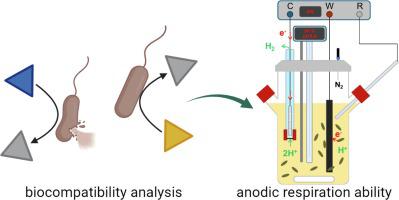当前位置:
X-MOL 学术
›
Bioelectrochemistry
›
论文详情
Our official English website, www.x-mol.net, welcomes your feedback! (Note: you will need to create a separate account there.)
Chemoorganotrophic electrofermentation by Cupriavidus necator using redox mediators
Bioelectrochemistry ( IF 5 ) Pub Date : 2024-03-18 , DOI: 10.1016/j.bioelechem.2024.108694 André Gemünde , Elena Rossini , Oliver Lenz , Stefan Frielingsdorf , Dirk Holtmann
Bioelectrochemistry ( IF 5 ) Pub Date : 2024-03-18 , DOI: 10.1016/j.bioelechem.2024.108694 André Gemünde , Elena Rossini , Oliver Lenz , Stefan Frielingsdorf , Dirk Holtmann

|
The non-pathogenic β-proteobacterium has the ability to switch between chemoorganotrophic, chemolithoautotrophic and electrotrophic growth modes, making this microorganism a widely used host for cellular bioprocesses. Oxygen usually acts as the terminal electron acceptor in all growth modes. However, several challenges are associated with aeration, such as foam formation, oxygen supply costs, and the formation of an explosive gas mixture in chemolithoautotrophic cultivation with H, CO and O. Bioelectrochemical systems in which O is replaced by an electrode as a terminal electron acceptor offer a promising solution to these problems. The aim of this study was to establish a mediated electron transfer between the anode and the metabolism of living cells, i.e. anodic respiration, using fructose as electron and carbon source. Since is not able to transfer electrons directly to an electrode, redox mediators are required for this process. Based on previous observations on the extracellular electron transfer enabled by a polymeric mediator, we tested 11 common biological and non-biological redox mediators for their functionality and inhibitory effect for anodic electron transfer in a -based bioelectrochemical system. The use of ferricyanide at a concentration of 15 mM resulted in the highest current density of 260.75µAcm and a coulombic efficiency of 64.1 %.
中文翻译:

Cupriavidus necator 使用氧化还原介体进行化学有机营养电发酵
非致病性β-变形菌能够在化能有机营养、化能自养和电养生长模式之间切换,使这种微生物成为细胞生物过程中广泛使用的宿主。在所有生长模式中,氧通常充当末端电子受体。然而,通气存在一些挑战,例如泡沫形成、供氧成本以及在含有 H、CO 和 O 的化学自养培养中形成爆炸性气体混合物。其中 O 被电极取代作为终端电子的生物电化学系统Acceptor 为这些问题提供了一个有希望的解决方案。本研究的目的是使用果糖作为电子和碳源,建立阳极和活细胞代谢(即阳极呼吸)之间介导的电子转移。由于无法将电子直接转移到电极,因此该过程需要氧化还原介体。基于之前对聚合物介体实现的细胞外电子转移的观察,我们测试了 11 种常见的生物和非生物氧化还原介体,以了解其在基于生物电化学系统中阳极电子转移的功能和抑制作用。使用浓度为 15 mM 的铁氰化物时,最高电流密度为 260.75μAcm,库仑效率为 64.1%。
更新日期:2024-03-18
中文翻译:

Cupriavidus necator 使用氧化还原介体进行化学有机营养电发酵
非致病性β-变形菌能够在化能有机营养、化能自养和电养生长模式之间切换,使这种微生物成为细胞生物过程中广泛使用的宿主。在所有生长模式中,氧通常充当末端电子受体。然而,通气存在一些挑战,例如泡沫形成、供氧成本以及在含有 H、CO 和 O 的化学自养培养中形成爆炸性气体混合物。其中 O 被电极取代作为终端电子的生物电化学系统Acceptor 为这些问题提供了一个有希望的解决方案。本研究的目的是使用果糖作为电子和碳源,建立阳极和活细胞代谢(即阳极呼吸)之间介导的电子转移。由于无法将电子直接转移到电极,因此该过程需要氧化还原介体。基于之前对聚合物介体实现的细胞外电子转移的观察,我们测试了 11 种常见的生物和非生物氧化还原介体,以了解其在基于生物电化学系统中阳极电子转移的功能和抑制作用。使用浓度为 15 mM 的铁氰化物时,最高电流密度为 260.75μAcm,库仑效率为 64.1%。



























 京公网安备 11010802027423号
京公网安备 11010802027423号